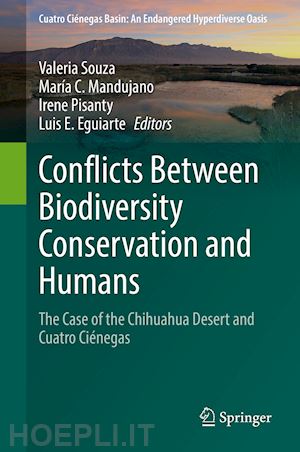Valeria Souza has a bachelor’s degree in Biology, master’s degree in Genetics and PhD in Ecology from the National Autonomous University of Mexico (UNAM). In 1990 Valeria worked with Rich Lenski at Irvine California (UCI), where she gained experience in experimental evolution. In 1993, she took on a research position at UNAM in Mexico, where she still works today. She was one of the first researchers worldwide to study the evolutionary ecology of microbes. In 1999, Valeria and Dr. Eguiarte were invited by NASA to explore a new world on an expedition that led them to study microbial biodiversity in an unlikely oasis in the Chihuahuan desert. She is an international honorary member of the American Academy of Arts and Sciences.
María del Carmen Mandujano studied Biology at the Metropolitan Autonomous University (UAM), and obtained her PhD from the National Autonomous University (UNAM), prior to completing her postdoctoral studies at New Mexico State University. She is currently a researcher at UNAM’s Ecology Institute, where she has been studying various ecological aspects of cacti in Cuatro Ciénegas and Mapimí, in the Chihuahuan Desert, and more recently in the drylands of Querétaro. She has made important contributions to the demography, life history and floral biology of desert plants, especially in cacti. She is the editor of Revista Cactáceas y Suculentas Mexicanas.
Irene Pisanty studied Biology at the School of Sciences (Facultad de Ciencias) of the National Autonomous University of Mexico (UNAM), where she also obtained her Master’s degree in Ecology and Environmental Sciences. She is currently an Associate Professor at the same School of Sciences, where she teaches on ecology, population ecology, natural resources and life histories. She is also interested in the implementation of environmental policies based on sound scientific knowledge and worked as a project manager for Ecosystem Conservation at the Commission for Environmental Cooperation (1995-1998), and as a senior advisor to the president of the National Institute of Ecology (INE) (2001-2007). She is currently exploring the responses of soils and plants to water overexploitation and the disturbances it is producing in the Basin, as well as the functional responses of plants in gypsum environments.
Luis E. Eguiarte studied Biology at the School of Sciences (Facultad de Ciencias) of the National Autonomous University of Mexico (UNAM), where he completed his PhD in Ecology in 1990. He subsequently did a postdoc at the Department of Botany and Plant Sciences, University of California at Riverside, under the direction of Professor Michael Clegg. He joined UNAM as an Associate Professor in 1992, and is currently a professor at its Department of Evolutionary Ecology. In 2011 he was awarded the Faustino Miranda Medal by the Institute of Ecology, UNAM, in recognition of his outstanding academic contributions to Ecology. In his research, he studies the evolutionary and ecological mechanisms that generate diversity and adaptation in different organisms, in addition to conservation genetics and the domestication of Mexican plants. He has studied these problems in plants (including Agave, Abies, Bursera, Cucurbita and Zea), in bacteria, in particular in Cuatro Ciénegas, Coahuila, in the Chihuahuan desert, and in various species of mammals and birds, using modern genetic and statistical methods and genomic data.











